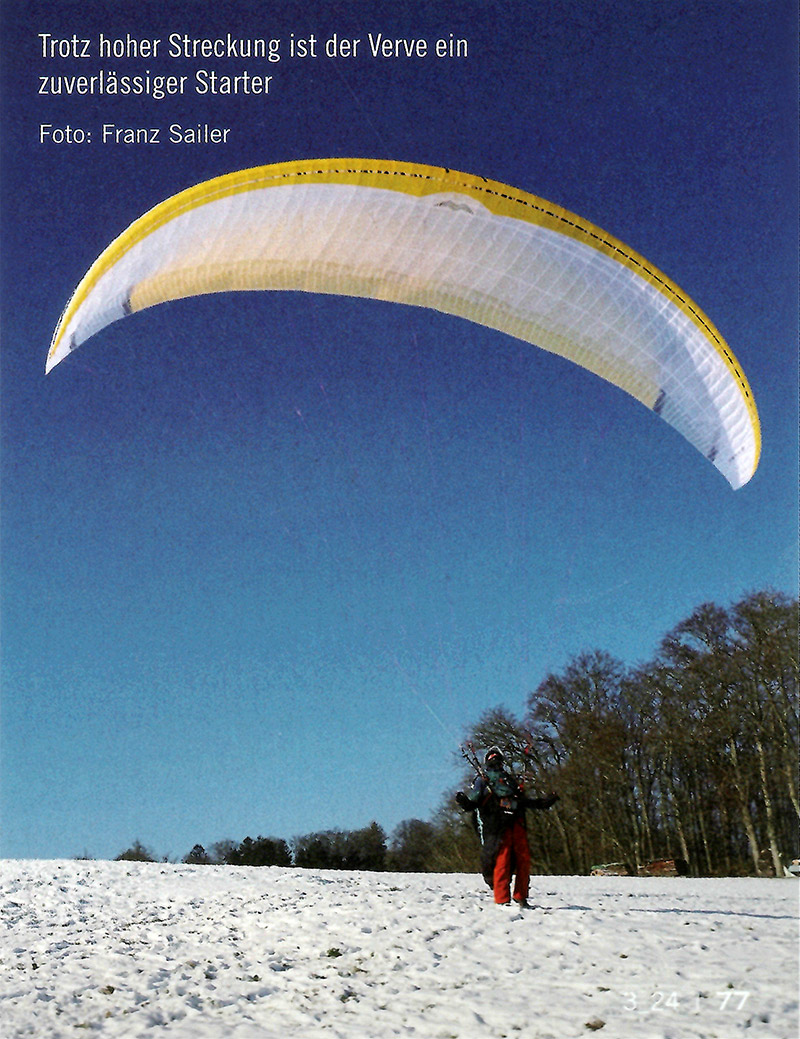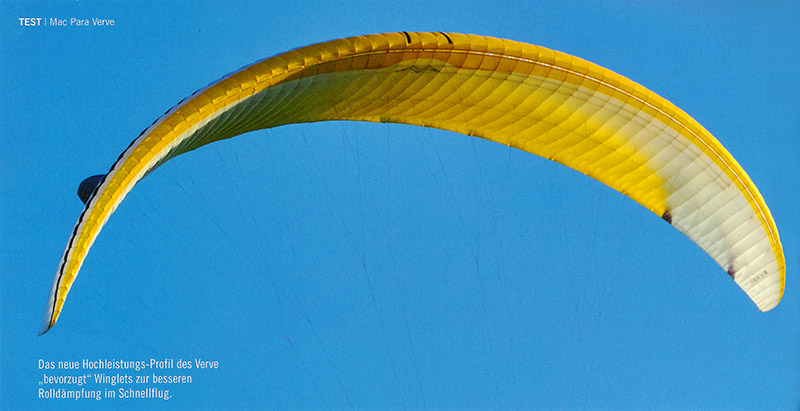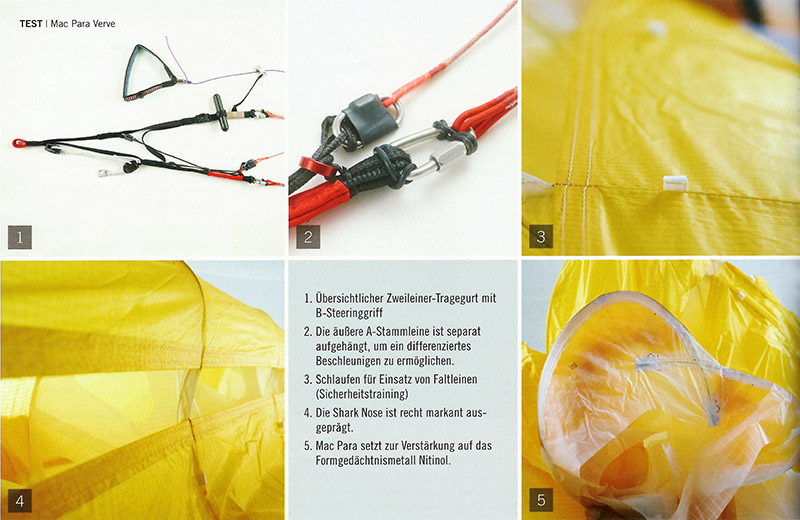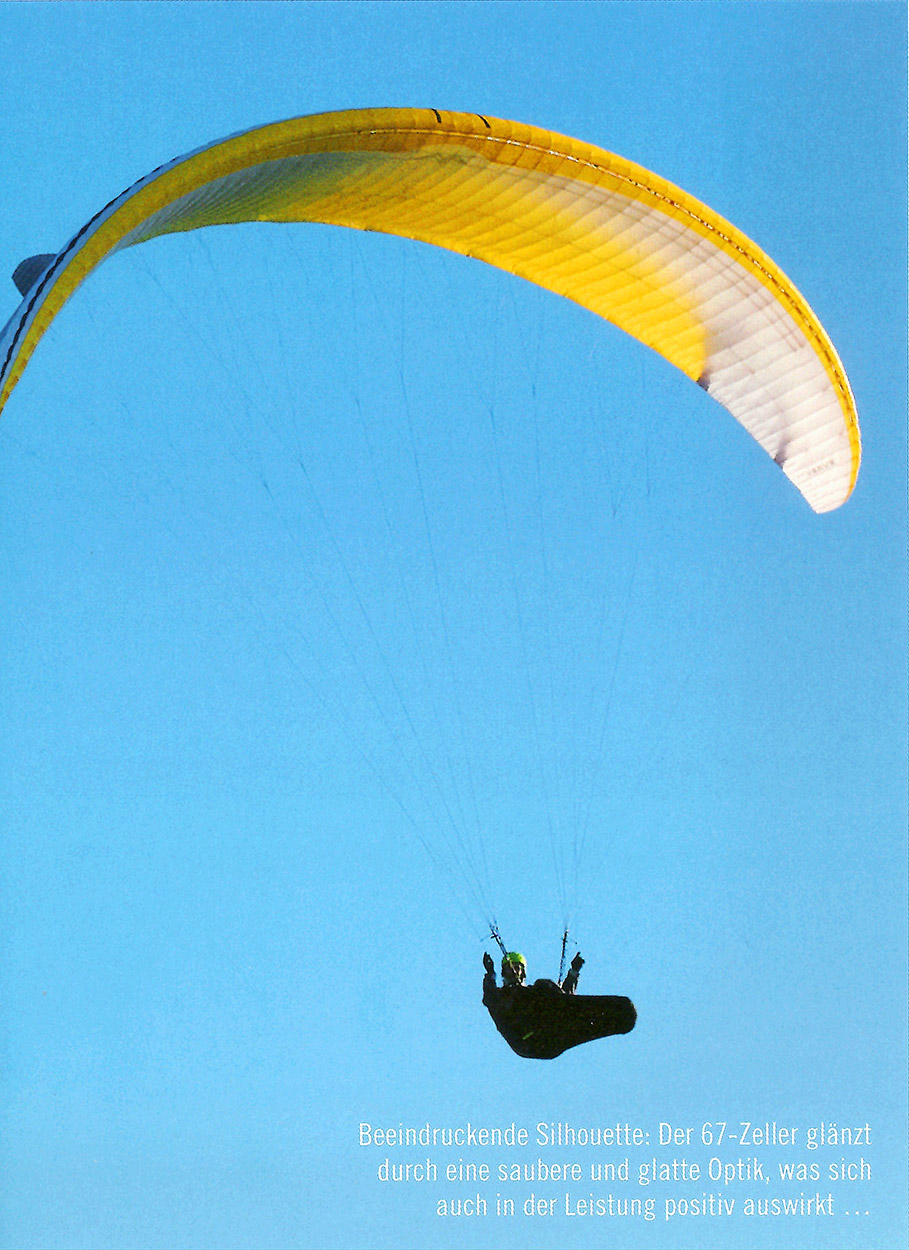Mac Para has set the bar high with the new EN-C two-line Verve and has invested a lot of time and intensive development work! The traditional Czech manufacturer comments on the result with clear words: “The most balanced two-line liner with the best handling that we have ever produced.”
Testpilot: Franz Sailer
Photos: Norbert Aprissnig
The Verve complements the well-known Elan series in the sports class. When designing Mac Para's first two-line liner in the C-Class, designer Peter Recek left nothing to chance. The Mac Para company boss and his team invested an enormous amount of development and time in the conception and fine-tuning of the new EN-C two-liner. That was also the reason why the Verve appeared as one of the last in the newly defined sports class. Numerous prototypes were flown... new plan shapes and profiles were tested... concepts were discarded... and ultimately the Verve got a completely new and eye-catching design, with winglets on the wing!
Mac Para comments on the target group as follows: “Thanks to its performance, the Verve is suitable for frequently flying pilots with XC ambitions who have an appropriate level of paragliding knowledge, i.e. for pilots who want high performance, dynamics, expect precision, agility and a high level of security at the same time. Its character and easy flight behaviour make the Verve to an ideal choice for pilots who want to move up from the high-end B category and do not want to miss the advantages of 'two-liner technology'. The Verve is a semi-light, high-performance glider and is also suitable for hike & fly." THERMIK team was able to extensively test the sleek two-liner with an aspect ratio of 6.6 in crispy mountain thermals in the high mountains of Morocco...
The Verve is based on the Elan 3 and the high-performance Magus. The canopy has 67 cells, with a designed aspect ratio of 6.6 and uses the technology of a fully reinforced profiles with thin Nitinol wires. Mac Para believes the great advantage of Nitinol reinforcement in that they cannot be deformed if the canopy is packed sloppily. In addition, the thin wires - Mac Para uses 0.8 and 0.6 mm wires - are even lighter than conventionally thick plastic rods and also reduce the packing volume of the canopy. The Nitinol rods in Mac Para gliders are equipped with fixed end caps to protect the fabric, which also shows the attention to detail here.
The profile of the Verve has been completely redesigned. In fact, several different profiles are used on the canopy, whose profile thickness, S-shape, etc. differ significantly. The new profiling on the wingtip wing increases roll agility at accelerated flight, which is why the Verve was equipped with winglets, similar to the Photon from Ozone. The winglets increase tracking stability and roll damping. The shape of the cells ensures aerodynamic optimization and at the same time offers the possibility of colour design of the canopy, explains the manufacturer. The negative 3D shaping on the leading edge, mini ribs and the new shape of the stabilizers help to reduce drag and therefore increase performance.

Mac Para is convinced the glider impresses with its high stability throughout the entire speed range and its gliding performance is comparable to the high-performance Magus. In addition, great importance was placed on flight comfort during the development. “The number of cells, the internal diagonal system and the line geometry — everything was optimized for the correct rigidity of the canopy so that maximum flight comfort is achieved in active air,” adds designer Peter Recek.
The Verve is made from proven materials with well-known quality and durability: The robust Skytex 32 Universal tissue with 32 g/m² is used on the leading edge of the upper and lower sails and the lighter Skytex 27 Classic II with 27 g/m² is used on the trailing edge of the upper and lower sails. For all ribs and diagonal ribs, Mac Para use the Skytex 27 and Skytex 32 “Hard finish” on the Verve.
“This mix gives the canopy the advantage of being both light and durable,” says the manufacturer. In fact, the glider in test size 25 only weighs 4.20 kg (weighed). Size 23 weighs just 3.85 kg and the smallest size 21 only weighs 3.65 kg!
The Verve is fitted with a total of over 106 suspension points as a classic two-line (three A and three B main lines). Special feature: The stabilizer line is tied to the outer A main line (it does not lead directly to the link) and, together with the outer A gallery, forms the outermost A main line. The line material used was classic unsheathed Aramid/Kevlar lines 8000 U series from Edelrid with a wide variety of diameters. The elegant 12 mm aramid polyester riser is featured with a baby A line. The stainless-steel links are secured with a rubber rings. The main steering line is led through the pulley to the brake toggle fitted with a swivel. The speed system uses Ronstan pulleys - elegant carbon C-handles and magnets with a snap-in function on the control toggles complete the high-quality risers.
The Verve has been approved in five sizes EN/LTF C and is produced in three serial designs. Clients can specify custom designs which are available if they wish.
“Off to the south, follow the sun” is my first thought when I unpack the Verve for the first time in the wintry, windy, “crappy weather".
The trip goes to Morocco for two weeks. Hopefully, relaxing soaring flights by the sea as well as a few extended XC flights in the Anti-Atlas are the vision. A week later I am already lying in a deckchair in the warm sun at the concrete “luxury launch site” Nidd’Aigle. The “Eagle’s Nest” is considered the “Bassano of Morocco”. Everything that flies into Morocco meets there at some point. The wind has already changed and is blowing lightly up the slope. Quickly sort the lines of my test glider! Well, the few main lines get quite snagged, but with a few skilful moves they can be separated and sorted in no time.
The best way to raise the Verve in zero wind conditions is to lay out the canopy in an arch. Laying out the canopy with a distinctive V-shape, aggressively pulling or pushing the risers forward tends to cause the wing tips to rush forward, allowing the canopy to create a light primary horseshoe. This delays the rising phase unnecessarily. Better: lay out the canopy with the A-lines (including the baby A-strap) taut. For those who are used to light gliders or are stepping up from B -category: The canopy with higher AR with the distinctive shark nose clearly takes a little longer to fill and release from the ground than a comparatively light glider with large inlet openings and few cells. If you continue to pull, the canopy rises sure and reliably to the zenith and hardly overshoots once there. All in all: With correct preparation and take-off technique, the Verve rises and takes-off without any problems even in zero wind.
Reverse Launch
Every now and then a few wingtip cells can roll up when the take-off wind is shifting and gusty; larger deformations remain the absolute exception thanks to the high internal canopy pressure.
It is enough to grab the inner A-straps to lift it up. When there is no wind or a very mild breeze, the wing prefers a slightly more pronounced initial impulse during the filling and rising phases. Then the canopy rises nicely evenly and on track to the apex. Once at the top, the wing doesn't stress and the pilot has enough time to make any corrections, as the Verve has hardly anytendancy to overshoot. Likewise, when there is a noticeable crosswind, the canopy does not require any tricks, but rises to the apex without any tendency to go to the side. Every now and then a few wingtip cells can roll up in a changing, gusty take-off wind; Larger deformations remain the absolute exception thanks to the high internal canopy pressure.
Wind over 15 km/h tends to blow the light bottom sail over the leading edge. This can be avoided by holding the pre-inflated canopy to the ground with active tension on the B-straps or brake lines. In this way, the Verve is perfectly fixed to the ground and remains beautifully tamed and does not rear up annoyingly in strong winds or flap wildly with its outer wings. Okay, sometimes an ear can loop through the stabilo lines (sloppily laid out!) and it takes a few attempts to pump it up to open. During the actual pulling, rising and stabilization process, the Verve behaves in an exemplary manner and forgives many mistakes in strong winds: the canopy is hardly prone to being levered out, even if the stressed pilot forgets to take a few quick steps to the canopy. The directional stability is high and gusty thermals rarely push the Verve off track. The big plus point in strong winds is that the wing hardly overshoots! The built-in pitch brake prevents the canopy from shooting forward significantly, so that the pilot rarely has to rein in the canopy.

The first two days of testing in Morocco are characterized by a mild sea breeze and weak thermals. After the take-off I have to fight for every meter in the weak thermal to stay up. Conditions in which the ability of the pilot is less important than the climbing behaviour of the glider and its floating properties. Great, as the only pilot, I can hold on for longer and the Verve carries me over the beautiful coastal landscape of Morocco for an hour or two. The Verve climbs perfectly in weak thermals if loaded correctly!
Christian Amon, test pilot at Mac Para, instructed me about the take-off weight at home: The Verve doesn't want to be heavily loaded. The manufacturer's recommended take-off weight for size 25 is 95 to 102 kg! I stick to it and weigh 98 kg today. With this take-off weight, the two-liner can be piloted nice and tight, yet flat, with the lowest sink rate at every turn on slopes or in weak thermal bubbles. In the normal working range only short control inputs are required for turns with a tight radius.
The controls react directly and precisely. You can also control the Verve very efficiently using weight-shift. This saves you from having to apply larger (performance-reducing) control inputs. A big plus if you have to fight at the beginning of long XC flight in weak morning thermals or weak evening thermals. The control forces are moderate to average in the normal working range. Only when fully loaded or when you have to “pull hard”, e.g. B. during tight turns or rapid changes of direction, do the forces become more pronounced.
Regarding the canopy feedback: The canopy has high internal pressure and is perceived as “well tensioned” in moving air. The two-liner indicates air movements through the wing tips or the risers. The steering lines, however, provide hardly any feedback. In mild thermals, the pilot is required to "listen" the wing and listen to the vario tones, because the tensioned canopy does not send too much information downwards. In bubbling thermals, however, the solid wing shows its full strengths...
The following days in the Anti-Atlas Mountains delivered perfect flying and thermal conditions. I could crank up to almost 3,000 m in crisp thermals and complete XC flights between 40 and 60 km in four or five hours and really test my Verve thoroughly (to the teeth). After the take-off near the mountain village of Tagdicht near Tafraoute, the Verve once again saved me from early bombing-out. For 30 minutes I struggle in weak, inversion-braked thermals... the "lid" keeps spitting me out... I sink massively again... and fight for every meter of altitude. Nevertheless, the two-liner doesn't stress me out: in the 96-102 kg take-off weight range, the wing pulls pleasantly neutrally into the thermal (without pitching up annoyingly or overshooting without input). I'm finally able to break through the stubborn inversion at 1,600 m, the climb values literally "explode" and I can force the Verve into the narrow tube with an increased lean angle. Turning in thermals is a lot of fun with the Verve! The two-liner offers extremely pleasant, balanced handling in thermal mode.
Rolling and pitching behaviour are perfectly coordinated. The glider pulls on the specified circular path and maintains the inclined position with super tracking stability. The Verve does not tolerate annoying vertical stabilisation or unnecessary diving. You could describe the Verve as an “agile flat-turning machine with no tendency to dive.” The taut canopy circles unwaveringly; constant, nerve-wracking course corrections with the control lines are not necessary. The Verve is extremely stable in thermal flight and provides a generous amount of flight comfort even in windy, torn thermals. The Verve does not show unmotivated pitching, inappropriate rolling movements, hard impacts on the risers or unpleasant levering in rough air. On the contrary! In turbulence, the glider runs above average, has a stable track and is resistant to collapses. This means I can enjoy the wonderful panorama of the Ammelntal and the surrounding 2,500 m high mountain backdrop in a relaxed manner, take photos and even cruise “hands-off”.
The flight comfort, which is above average for this class, will particularly appeal to those moving up from the B class. Likewise, the canopy does not overwhelm the pilot with unnecessary information by causing the outer wing to constantly wobble or bend. Accordingly, the Verve requires few control inputs. Sure, from time to time the outer wing can be supported in turbulent air or prevented from pitching discreetly with a short braking input. Nevertheless - in big air, the glider absorbs the air movements very elegantly. It twists a little or is occasionally pushed to the side, but it doesn't collapse. Classic deflation on the wingtips (ear collapse) are very rare. Even in difficult conditions, the Verve shows pleasant agility with gentle movements; it can hardly be tempted into dynamic reactions.
Many two-line gliders in this class require significantly more active pilot control or more pilot experience in tricky conditions than this Mac Para performance glider.

Accelerated flight
The 25 km long ridge above the Ammelntal has its pitfalls. In the afternoon, the west/northwest wind often blows in from the sea towards the mountains. So today and for the next two days I have to deal with a strong headwind of around 15 km/h on the return flight. In addition, strong thermal separations are sweeping up the southwest slopes, so I feel uneasy about pushing the accelerator more than 70% through close to the relief.
Does the Verve remain stable even at full throttle? Well, it stayed that way and didn't give me any cause for concern in the total of 25 hours of testing! The top speed was 55-56 km/h during TOW of 103 kg at approx. 1,700 m. Definitely sufficient value for a C class. When fully loaded, a top speed of just under 57 km/h should be achievable. The B handles only need to be activated occasionally for pitch corrections. Thermal separations can occasionally push the Verve off track and cause the canopy to roll subtly. However, thanks to the roll-stabilizing winglets, the pendulum movements are limited, so that the B-handles only have to be used occasionally to correct direction. The pulling forces for B steering are slightly higher, so it is good that corrections remain at a manageable extent.
Regarding gliding performance in high-speed flight: Mere subjective impressions must not be equated with objective, meaningful comparison flights under complex, suitable test conditions (same wing loading, harness, wing sizes, etc.). Nevertheless: Several comparison flights with EN-D certified gliders have shown that the Verve is clearly on the upper edge in its sports class and therefore in the higher-class of comparison when it comes to gliding performance in fast flight.
The Verve is definitely a lot of fun, goes around corners quickly and invites you to play! In high wingovers, you have to tighten significantly to allow the canopy to reach its full potential. The high aspect ratio of 6.6 is easy to handle because the outer wings remain stable for a long time.
During thermal flight there were only a few harmless ear deflations. - During speed flight, the canopy always remained stable. Therefore, no statements can be made about collapses and reactions to them. Representative side and front collapses must be simulated in an SIV with folding lines. Appropriate loops for a folding line are attached to the front of the lower sail.
The wing spirals very nicely! One circle to initiate ...tighten harder...after two turns the canopy goes on the nose. The glider reacts very precisely to changes in controls and weight. The Verve independently returns from a full spiral around sinkrates of -10 m/s. At significantly higher sink values, the canopy slows down the rotation speed and turns noticeably during the actual exit. Typical for the class!
Baby A descent: Big ears using the "Baby” A1 strap can only be performed whilst applying a lot of force. First accelerate 30-40%, then reach high up on the outermost A line... now pull down strongly and deeply. The ears can flap and recover if the canopy starts to roll or the hands stay too high up. The forces needed to maintain the ears are high, the correct holding height must be found so that the ears remain stable. The sink rates in combination with the speed system are attractive, but keeping the entire manoeuvre stable in moving air requires practiced technique. The ears open independently and with a snap, a few small outer cells may “stick together” in the gallery.
B3 descent: Again, first activate the accelerator 30-40%. Grab the outermost B-lines high up and pull them down firmly. The forces requiredare similar to those of the Baby A method. The wing now “folds” the outer wing backwards/inwards. The manoeuvre is much easier to hold and the ears remain stable. However, the efficiency is lower than with the conventional method. Again,opening takes place promptly.
It's best to test and find out which of the two methods you prefer.
Not possible due its construction!

Well done! The extensive development and testing was worth the effort. The Verve is wonderfully balanced around all flight axes, leaving nothing to chance when fine-tuning the trim. The result is an EN-C two-liner glider with excellent handling and above-average flight comfort for this class. Those moving up from the B class will appreciate that the wing shows manageable reactions even in tricky conditions and conveys a lot of confidence thanks to its smooth flight and high stability. The best comes last: The gliding performance is at the top of the sports class across the entire speed range. Ambitious XC pilots will often lead the pack and have a grin on their face on long gliding sections.
A further clarification on the climbing behaviour of the Verve, when flown within the manufacturer's recommended take-off weight, the wings climbrate is exemplary, even in weak thermals. This needs to be emphasized again at this point, as completely distorted impressions arise when self-proclaimed (but equally renowned) test pilots load the glider to the upper limit or even fly it overloaded. Thanks to its low weight and its problem-free take-off behaviour in all wind conditions, the Verve is clearly ideal for hike & fly and will ensure a good feeling even in difficult take-off locations.
With the overall package of performance and flight comfort, the Verve sets new standards in the C-Class and is currently certainly the benchmark device that competitors will have to beat in the future when viewed as an overall package.
From all EN C two-liners that I have tested so far, I liked the Verve the most. A two-liner that full fills all wishes: great overall performance, high flight comfort, great handling and above-average stability in turbulence.
What do you want more?